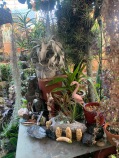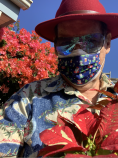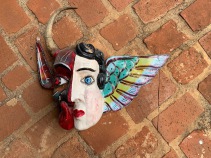orthobionomy as art
I was reading A Little Book on Form, by poet Robert Hass and to make some point he quoted at some length from James Joyce, Portrait of the Artist as a Young Man. Several points here struck a chord with me, thinking about the process of an Ortho-Bionomy session. Here is what Hass quoted:
-To finish what I was saying about beauty, said Stephen, the most satisfying relations of the sensible must therefore correspond to the necessary phases of artistic apprehension. Find these and you find the qualities of universal beauty. Aquinas says: Ad pulcritudinem tria requiruntur, integritas, consonantia, claritas. I translate it so: Three things are needed for beauty, wholeness, harmony, and radiance. Do these correspond to the phases of apprehension? Are you following?
-Of course, I am, said Lynch. If you think I have an excrementitious intelligence run after Donovan and ask him to listen to you.
-Look at that basket, he said.
-I see it, said Lynch.
-In order to see that basket, said Stephen, your mind first of all separates the basket from the rest of the visible universe which is not the basket. The first phase of apprehension is a bounding line drawn about the object to be apprehended. An esthetic image is presented to us either in space or time. What is audible is presented in time, what is visible is presented in space. But temporal
or spatial, the esthetic image is first luminously apprehended as self-bounded and self-contained upon the immeasurable background of space or time which is not it. You apprehend it as one thing. You see it as one whole. You apprehend its wholeness. That is integritas.
-Bull’s eye! said Lynch, laughing. Go on.
-Then, said Stephen, you pass from point to point, led by its formal lines; you apprehend it as balanced part against part within its limits; you feel the rhythm of its structure. In other words, the synthesis of immediate perception is followed by the analysis of apprehension. Having first felt that it is one thing you feel now that it is a thing. You apprehend it as complex, multiple, divisible, separable, made up of its parts, the result of its parts and their sum, harmonious. That is consonantia.
-Bull’s eye again! said Lynch wittily. Tell me now what is claritas and you win the cigar.
-The connotation of the word, Stephen said, is rather vague. Aquinas uses a term which seems to be inexact. It baffled me for a long time. It would lead you to believe he had in mind symbolism or idealism, the supreme quality of beauty being a light from some other world, the idea of which the matter was but a shadow, the reality of which it was but a symbol. I thought he might mean the claritas was the artistic discovery and representation of the divine purpose in anything or a force of generalization which would make the esthetic image a universal one, make it outshine its proper conditions. But that is literary talk. I understand it so. When you have apprehended that basket as one thing and have then analyzed it according to its form and apprehended it as a thing you make the only synthesis which is logically and esthetically permissible. You see that it is that thing which it is and no other
thing. The radiance of which he speaks is the scholastic quiditas, the whatness of a thing. This supreme quality is felt by the artist when the esthetic image is first conceived in his imagination. The mind in that mysterious instant Shelley likened beautifully to a fading coal. The instant wherein that supreme quality of beauty, the clear radiance of the esthetic image, is apprehended luminously by the mind which has been arrested by its wholeness and fascinated by its harmony is the luminous silent stasis of esthetic pleasure, a spiritual state very like to that cardiac condition which the Italian physiologist Luigi Galvani, using a phrase almost as beautiful as Shelley’s, called the enchantment of the heart.
Stephen paused and, though his companion did not speak, felt that his words had called up around them a thought-enchanted silence.





